|
|
|
Tharp's Thoughts
Weekly Newsletter
|
|
|
|
|
|
|
|
-
Feature: September 2017 Market Update:
Bull Quiet Market Type, by RJ Hixson for Van K. Tharp Ph.D.
-
Workshops: Forex Trading Systems Coming this November!
-
Tips: The SQN Report, by RJ Hixson for Van K. Tharp Ph.D.
-
|
|
|
|
Three Workshops In London Next Month!
|
|
Attend all three and qualify for an additional $900 discount!
(In addition to the early bird discounts.)
Scroll down for more information on these workshops and to reserve your seat today.
|
|
|
|
September 2017 Market Update:
Bull Quiet Market Type
by RJ Hixson for Van K. Tharp Ph.D.
|
|
|
|
|
I always say that people do not trade the markets; they trade their beliefs about the markets. In that same way, I'd like to point out that these updates reflect my beliefs. I find the market update information useful for my trading, so I do the work each month and am happy to share that information with my readers. If your beliefs are not similar to mine, however, then this information may not be useful to you. Thus, if you are inclined to go through some sort of intellectual exercise to prove one of my beliefs wrong, simply remember that everyone can usually find lots of evidence to support their beliefs and refute others. Simply know that I admit that these are my beliefs and that your beliefs might be different.
These monthly updates are in the first issue of Tharp's Thoughts each month which allows us to get the closing data from the previous month. These updates cover 1) the market type (first mentioned in the April 30, 2008 edition of Tharp's Thoughts), 2) the debt statistics for the US, 3) the five-week status on each of the major US stock market indices, 4) our four-star inflation-deflation model, and 5) tracking the US dollar. I also write a report on the strongest and weakest areas of the overall market as a separate SQN™ Report. Significant market changes may mean the SQN Report comes out more than once a month.
Part I: The Big Picture
The equity markets right now continue in Bull Quiet mode. The S&P has been in Bull or Strong Bull since early in the year. For the first time since then, however, the Market SQN score dipped into the Normal (or sideways) range for a few individual days in August. Does that portend a sideways market or a Bear? In itself, no. A sideways market and increasing volatility often precede a bear market but at the beginning of September, we have neither a sideways direction nor volatility that is even close to normal. The market type classification system that Van uses is descriptive of today’s conditions, not predictive of tomorrow’s.
|
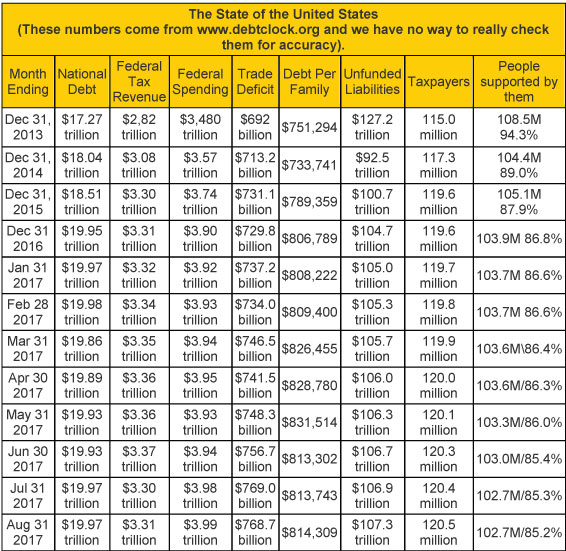
|
|
How do you react to the numbers in this table about the level of debt that Van includes every month? Personally, I find the numbers numbing and I tend to skim past this section with thoughts like “those amounts are unfathomable” or “the issues are intractable”. When I actually have to calculate and transfer figures from www.usdebtclock.org however, they get my attention.
The US has (and arguably other countries have as well) a debt problem. It’s not being worked on. It’s not going away. It’s not even being addressed. In fact, congress returns to DC this week with September intentions of raising the federal debt ceiling. They are kicking the can down the road — at least past the next few elections. Am I kicking the can down the road too by not writing my representatives about dealing with the issue now?
Van includes this section every month so that it stays in your foreground. Massive debt affects economies, international relations, traders and families. Consider how the level of debt influences your big picture for trading and how it will affect your children.
Part II: The Current Stock Market Type Is Bull Quiet
Van uses the Market SQN score for a 100 day period to determine the directional component of his market type. At the end of August, the market is in Bull mode. Van also monitors the Market SQN score for 200 days, 50 days, and 25 days to assess the bigger picture. Right now, the 200 day Market SQN score is Bull, the 50 day score is Neutral, and the 25 day score is Bear. 25 days back puts us at the end of August, 50 days back is in late June, 100 days back is mid April, and 200 days back is mid November. You may be able to look at the weekly bar chart below and understand the market directional mode given what the market has done for each period.
|
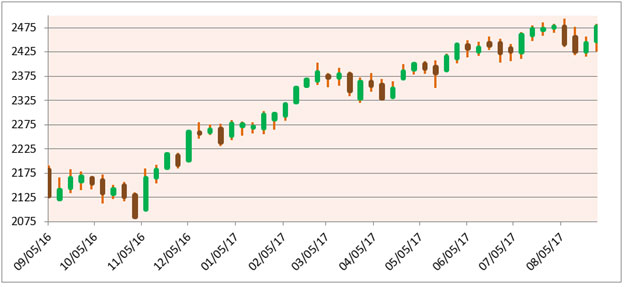
|
|
In the Market SQN chart below, you can see how the score has migrated over the last year. The market has been in the Bull zone since mid-June and you can see the few days in August where the score dipped into the Neutral (sideways) zone.
|
|
In spite of some large daily moves in the S&P and broader market in August, volatility remains Quiet on an historic basis. The big daily moves did get volatility off the bottom of the chart but as you can see, the line still resides safely in the blue.
|
|
The table below reports the three major US Indices levels through the end of August. The Dow and the S&P hit all-time highs in early August. The Nasdaq hit its own all-time high in late July. Since then, the Dow and S&P have not returned to their respective new highs — though they are close. The Nasdaq, however, hit a new all time high on Friday, September 1. As of August 31, the Nasdaq is the best performing index, though the Dow and S&P have done well also.
|
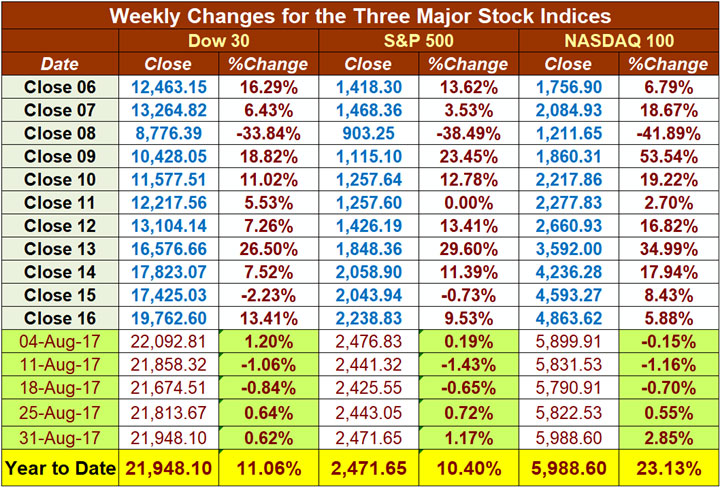
|
|
The Russell 2000 Index (not tracked here) is well off its July high. Would this count as divergence? If not, what do you take the differences to mean? If this does represent divergence for you, what does that mean? Do you notice what you believe about the indexes, divergence, market performance and how all of that affects your thinking — and your trading?
Part III: Our Four Star Inflation-Deflation Model
Gold and basic materials gained in August which produced inflationary component scores and a model score for inflation. See the historical numbers for previous years and the monthly figures for the last year —
|
|
Commodities still earned a deflationary score in August but only at a mild level. Another positive model score in September might signal an inflationary trend has begun.
|

|
|
Part IV: Tracking the Dollar
From its high at the start of the year to its low in August, the USD is down 12%. Compare that kind of move with equities in the same period. For example, going long the EUR/USD currency pair (long the Euro, short the Dollar) at the start of the year would have put your position gain ahead of the gains for the Dow and S&P. If you bought and held the Dow or S&P, your position would be worth slightly less than at your entry on a relative basis against the Euro. You could not have known all of this at the beginning of the year of course, but consider a few questions —
- How do you know if/when a major asset (especially an important one for any American) is in a trend?
- What do you do, if anything, when that notice that happening?
- What will you do, if anything, if the dollar resumes its slide?
While you might not have “felt” the Dollar’s loss in relative value since the start of the year, you could at least consider how it affects you and how you could trade it.
If Van measured this kind of thing, the USD Index looks like it would probably be a Bear Quiet market type now — but we lack any market type research on it. See what you think —
|
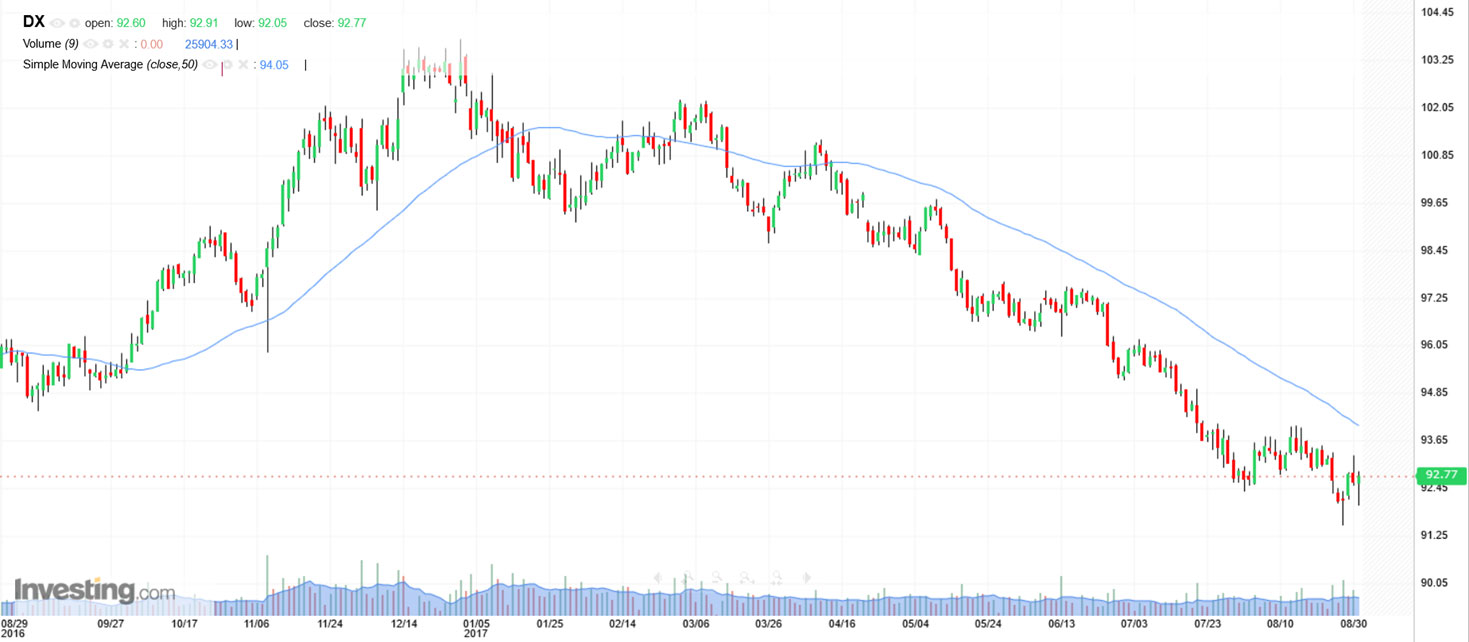
|
|
Do you believe in the technical idea of support? If so, you might wonder if the US Dollar Index found it in late August. You can see an important April 2016 low in the weekly bar chart below of the USD Index. Now we’ll see if that support holds or yields.
|
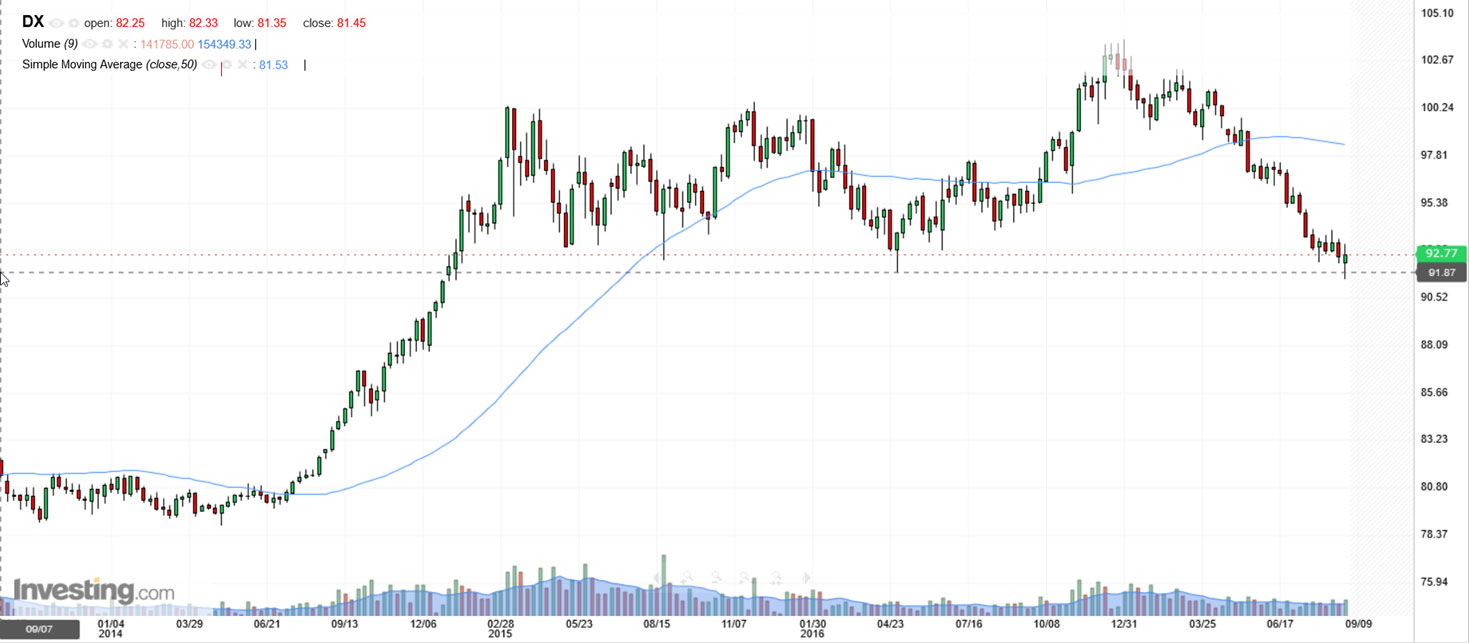
|
|
Conclusion
Today, equities are in a Bull Quiet market type. The market type has been either Bull Quiet or Strong Bull Quiet for many months. Does the market type have to change any time soon now that it has gone on so long? No. Will it change soon? Maybe. It will change sooner or later. When will we know? When it changes. Then why bother with market type if it doesn’t help you know what’s coming . . . ?
Van monitors market type because it helps traders know which kind of trading systems they should be using right now. Systems that perform well in a Bull Quiet market type should have been performing really well for the last few months — and right now. Bull Quiet type systems are relatively easy to design (think buy and hold with a trailing stop) but Van would also encourage you to define different trading systems for different market types. If the market were to switch to a Sideways Quiet type, you would stop using your Bull Quiet systems and start using your Sideways Quiet systems. Rather than trying to predict what the market will do and how to be proactive with your positions ahead of the market, simply know the market type and trade the appropriate systems.
This approach makes a few assumptions —
- You have a market type classification system and you use it. Van’s market type classification system works well for him but maybe some other way fits you instead. If that’s the case, how would you go about describing and classifying market conditions?
- You understand trading systems. You know the parts of a full system, the purpose of each, and how they work together. You understand the system’s edge and the beliefs behind it that enable the system to profit.
- You have a trading system development process and can develop one or more systems for each market type. So many newer traders work on developing a trading system that performs well all the time. If that’s what you have been trying to do, save your time and effort — focus on one particular set of market conditions per system.
- You trade one or more systems created for the current market type. (Some trading systems may perform best in one market type but will perform acceptably well in one or two other market types also.)
We are in September and October is just weeks away. Already, precautionary headlines have been popping up about historical market behavior in the fall months. Notice your thoughts and feelings about those topics — but pay attention to the market type, however you define it.
Note: Van has returned home from his driving trip and will be writing the next Market Update for you at the beginning of October
|
|
|
|
|
|
About the Author: R.J. Hixson is a devoted husband and active father. At the Van Tharp Institute, he researches and develops new products and services that help traders trade better. He is the lead instructor for several VTI workshops and a co-instructor alongside Van Tharp in the Peak Performance workshop series. He can be contacted at “rj” at “vantharp.com.”
|
|
|
|
|
|
|
|
|
Presented by Van Tharp
with co-presenter RJ Hixson
|
|
|
|
September 15-17
Friday-Sunday
|
|
|
|
|
|
|
|
|
|
Exciting New Work from Van Tharp
|
|
|
|
September 19-21
Tuesday-Thursday
|
|
|
|
|
|
|
|
|
|
October 2017 LONDON, ENGLAND
|
|
|
|
Presented by Van Tharp
with co-presenter RJ Hixson
|
|
|
|
October 13-15
Friday-Sunday
|
|
|
|
|
|
|
|
Peak Performance 101 is Dr. Tharp's core psychological workshop, and his most transformative course for over 25 years. If you want to know how great traders think, behave and act so you can achieve consistent and profitable results, without stress, then this workshop is for you.
|
|
|
|
Presented by RJ Hixson
and Van Tharp
|
|
|
|
October 17-19
Tuesday-Thursday
|
|
|
|
|
|
|
|
We'll teach you one of the real secrets of success — how to use all the system building blocks to design a trading system in such a way that it fits your personality and style of trading.. In the process of learning how to do this, you'll probably come up with dozens of winning systems that will work because they'll be based on criteria that fit your situation.
|
|
|
|
|
|
October 21-23
Saturday-Monday
|
|
|
|
|
|
|
|
Watch the brief 2 minute video below to get an insider's look on attending this workshop.
|
|
Van shares years of knowledge about wealth concepts, wealth creation modeling, being wealthy inside, and the infinite wealth processes. Attend this workshop and completely reshape your attitudes toward money, work, paychecks, income, wealth, scarcity, and abundance. Your paradigm shifts in just three days will amaze you and release you from your current beliefs about wealth that have been running in your unconscious and holding you back.
|
|
|
|
Presented by Gabriel Grammatidis
|
|
|
|
November 10-12
Friday-Sunday
|
|
|
|
|
|
|
|
|
|
Presented by Gabriel Grammatidis
|
|
|
|
November 13-14
Monday-Tuesday
|
|
|
|
|
|
|
|
Learn to Trade Three Forex Trading Systems with an Edge
Gabriel will be teaching three robust Forex systems based on trend-following. Each system is based on similar “ingredients,” but each has a different recipe to capture a different part of the trend. Consequently, the systems are complementary to each other and together offer several trading setups nearly every day of the year. Start your study early. Order the Forex Home Study Course now and walk through the door with a thorough understanding of the Busted Breakout (System 1).
Join us for this three-day workshop and leave prepared to trade the systems right away. Plus, join us for 2 days of live Forex trading so you can trade the systems live for even more hands on experience!
|
|
|
|
August 2017 System Quality Number® Report
The SQN®Report
by RJ Hixson for Van K. Tharp Ph.D.
|
|
|
|
|
There are numerous ETFs that track everything from countries, commodities, currencies and stock market indices to individual market sectors. ETFs provide a wonderfully easy way to discover what’s happening in the world markets. I apply a version of my System Quality Number® (SQN®) score to measure the relative performance of numerous markets in a world model.
The Market SQN score uses the daily percent change for input over a 100-day period. Typically, a Market SQN score over 1.47 is strongly bullish and a score below -0.7 is very weak. The following color codes help communicate the strengths and weaknesses of the ETFs in this report:
- Dark Green: ETFs with very strong Market SQN scores > 1.47
- Light Green: ETFs with strong Market SQN scores (0.70 to 1.47).
- Yellow: ETFs with slightly positive Market SQN scores (0 to 0.70). These are Neutral/Sideways
- Brown: ETFs with slightly negative Market SQN scores (0 to -0.7).
- Red: Very weak ETFs that earn negative Market SQN scores (< -0.7).
This is basically the same rating scale that we use for the Market SQN Score in the Market Update. The world market model spreadsheet report below contains a cross section of currently available ETFs; excluding inverse funds and leveraged funds. In short, it covers equity markets around the globe, major asset classes, equity market segments, industrial sectors, and major currencies.
World Market Summary — Equities & Currencies
Each month we look at the equities markets across the globe by segment, region, and sector.
For the fourth month in a row, the US Dollar is the weakest currency and in August, the USD ETF (UUP) became the weakest symbol in the entire database (last month it was the second weakest). This model is based on the USD so the rest of the world looks better as a result of the weak Dollar.
Overall, the US market segments look much like last month with only one color shift. The midcap value ETF (IJJ) went from yellow to brown with a slightly negative Market SQN score. The rest of the mid-cap and small cap segments were positive but weak and the large cap segments were all green. The Dow is a dark green which indicates strength.
Perhaps not surprisingly, the US market sectors show the full range of scores from red to dark green.
In the Americas geography, country market scores are all positive — either yellow or green. Global equities ex-US and emerging markets are both dark green.
Asia put in another mostly green month again though with a few less dark green markets. The China offerings all remain very strong. Australia and India are the same two countries as last month that are not in green. A price data problem may be the issue with the India ETF (ICN) because the NSE index is up about 10% from 100 days back.
Europe is slightly weaker in August than July with a net gain of 5 light green country scores compared to the 12 dark green countries last month. There are two brown scores of 0.00 - which probably indicate data issues as well. If that’s the case, then Russia is the only weak market in Europe.
|
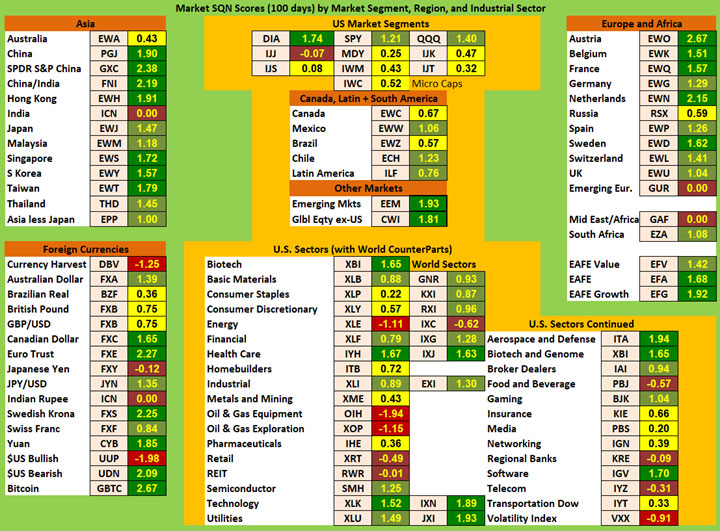
|
|
As mentioned, the US Dollar is the weakest ETF in the database this month and it remains the only red currency – but at a slightly less negative score than last month. DBV is red too but that’s not a currency; the ETF uses a carry strategy that’s not working so well right now. The Euro and the Swedish Krona are the strongest traditional currencies again this month both with scores over 2. Bitcoin, a crypto-currency, has one of the strongest scores in the database — stronger than the Euro or Krona. The Yen went negative this month but everything else is positive. The Brazilian Real and the British Pound are the weakest of the bunch. Again, I suspect a
data issue is the cause of the 0.0 score for the Indian Rupee ETF.
In the US stock market sectors, Biotech, Health Care, Technology, Aerospace, Biotech+Genome, and Software all earned dark green scores. This is a noticeable gain of very strong sectors over last month - in July, only two sectors came up very strong. None of the dark green sectors were strong enough to make the top list but the very weak score for the three Energy/Oil & Gas sectors put them on the bottom list. Due to a little volatility coming into the market in August, the VIX based ETF (VXX) is still negative — though not as negative as in the last few months.
Commodities, Real Estate, Debt, and the Top and Bottom Lists
Commodities are a mixed bunch again. Oil is the only red issue this month with Natural Gas also coming in negative. Blended Commodities (DBC), Silver, Natural Gas, Agriculture, and Livestock make up a similar brown colored list as last month’s brown issues. Base Metals went from yellow last month to the only dark green commodity this month. Gold and silver are scoring differently in August as they did in July. Unlike the other two energy ETFs, Coal is positive.
Everything in real estate is green again in August — but not all of them are dark green this month. Real Estate and REITs ex-US turned light green this month. All of the interest rate products except TIPS bonds are green again this month. Short Term, Corporate, and High Yield Bonds were dark green last month in this category but weakened to light green this month. Overall, the Market SQN scores for debt weakened in August.
|
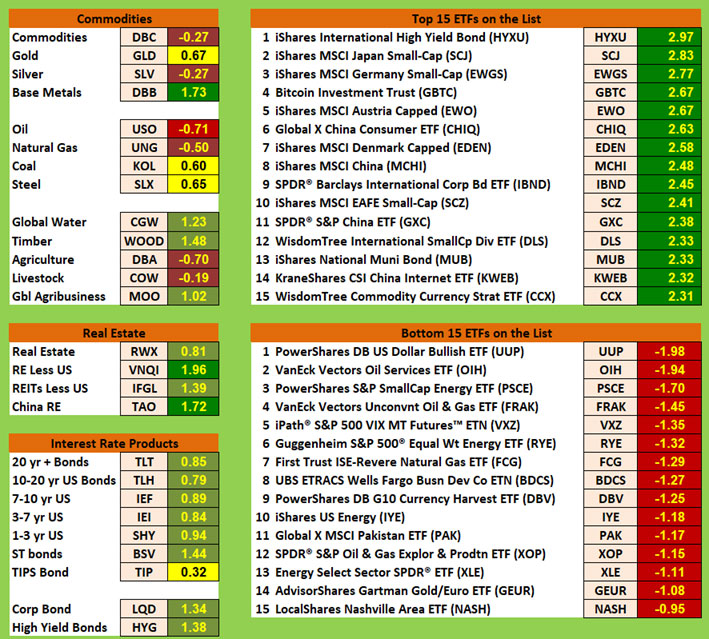
|
|
The Top Ranking List:
The top ranking list has less strength than July’s list — nothing bested a score of 3.0 in August whereas July’s list had six ETFs scoring 3+. China, various small-cap issues, bond funds, and many international offerings populate the top list at the end of August.
The Bottom Ranking List:
This month’s bottom list is different than last month’s list and it’s a little hard to net out a clear theme in the differences. Last month, there were two scores less than -2 but also two brown ETFs on the list. Now, everything is red but nothing scored lower than a -2. Energy related issues dominate the bottom list. And what’s going on in Nashville that its ETF wound up here? (Furthermore, why is that ETF even in this model? No offense to Nashville and its industrious people but NASH will likely be gone from the model’s database by next month’s report.)
Summary
Let’s look at the summary table which measures the percentage of ETFs in each of the strength categories. You can see the distribution of the database by Market SQN score in bullish, neutral and bearish categories just below with the August 31 figures at the bottom of the table —
|
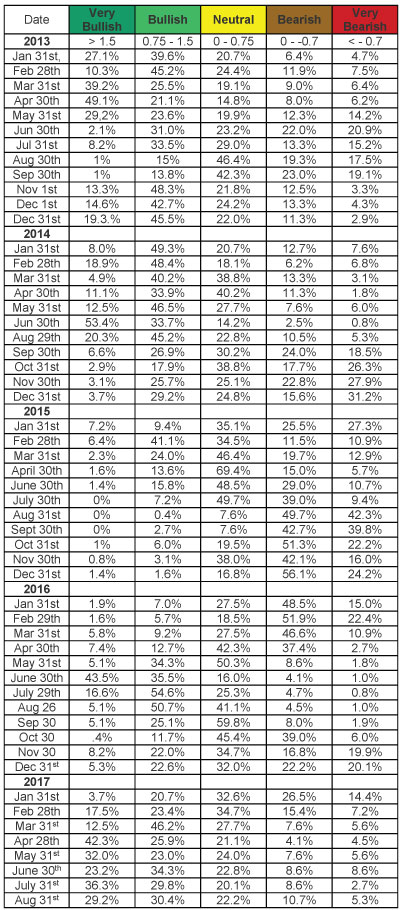
|
|
The trend over the last few months of a strengthening database may have turned this month – or maybe it just stalled. The database went from 66%/ 20%/ 11% (bullish/neutral/bearish) in July to 60%/ 22%/ 16% in August. August’s change was not a major one but noticeable. Perhaps this shift relates to the still negative but improving score of the USD? The next few months’ scores may give us some clues.
Be careful to base your actions upon what IS happening, not what you think might happen. The markets always offer opportunities, but to capture those opportunities, you MUST know what you are doing. If you want to trade these markets, you need to approach them as a trader, not a long-term investor. We’d like to help you learn how to trade professionally because trying to navigate the markets without an education is hazardous to your wealth. All the beliefs given in this update are my own. Though I find them useful, you may not. You can only trade your own beliefs about the markets.
|
|
|
|
NEW E-learning Course!
Forex Trading Systems: The Busted Breakout System
Click on the image below to watch a brief 1 minute video that hightlights this new course.
|

|
|
Gabriel developed and refined his Busted Breakout system on the concept of trend-following while he was still enrolled in the Super Trader program.
The system has a high win rate (about 65%) and it takes advantage of a price pattern that happens again and again in the charts — breakout failures. The main advantage of this is that it benefits from running for other peoples’ stops. This is a unique edge of the system making the trade break-even early on. Watching 15-minute charts for 4-6 hours a day and trading only the biggest, most liquid currency pairs, the system finds easily more than 150 trades per year. The pattern works equally well on 5min, 60min and 240min charts so the trade opportunity per year can be much higher depending how you trade. Gabriel is confident that someone with the programming skills could turn the system into a well-performing automated trading system.
The three-day workshop cost is $3,995 but the cost of the home study program is $1,295. As a special introduction price for early responders you can get this new home study for just $995.
Plus, buy the home study now and if you decide to join us at the 3-day Forex Trading workshop in November (or for any Forex workshop in the future), you can deduct $600 off of your course payment for the workshop.
This is win-win for all! If you are among the group of clients who simply cannot come to one of our workshops this home study offers you the benefit of still gaining access to a robust and premium forex trading system. Gabriel has traded it himself in several timeframes for many years now offering a persistent edge in the market.
But, if you have already been considering attending the workshop this is a great way for you to get a full-steam head-start and walk through the workshop door already understanding the system well. You will then have the opportunity to ask Gabriel anything you need. And in addition, learn two new Forex trading systems. The three systems taught in the workshop all offer unique advantages. They complement each other giving you the opportunity to reap various stages in a trend.
|
|
|
|
FREE Book!
We pay for the book, you just pay for shipping.
Read Van’s Latest Book —
TRADING BEYOND THE MATRIX
The Red Pill for Traders and Investors
Eleven traders tell their stories about transforming
their trading results and lives, in this 400 plus page book.
Below is a brief video on how powerful this book is to traders.
|
|
|
|
Cary, NC Workshop Information
For a list of nearby hotels for our Cary, North Carolina locations,
click here.
Book your flight arriving to the Raleigh-Durham International Airport (RDU).
When traveling to a three-day course, it's best to arrive the evening before.
To help determine your arrival and departure times, see:
Questions? Click Here to Ask Van...
CONTACT US
This is a supplement to our subscription based newsletter, Tharp's Thoughts.
800-385-4486 * 919-466-0043 * Fax 919-466-0408
|
|
|
|
|